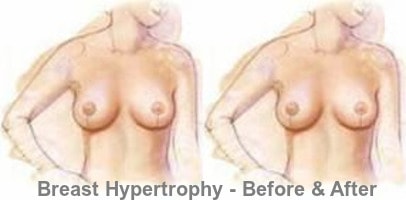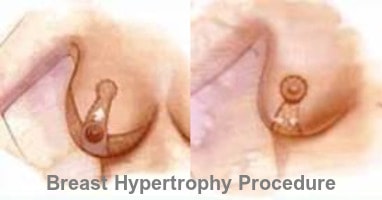Breast Reduction
Breast reduction or reduction mammaplasty is a procedure that reshapes the breasts in order to make them smaller, lighter, and firmer. Reduction is accomplished by removing excess fat, glandular tissue, and skin. Breast Reduction can be performed at any age, but it is usually recommended to wait until breast development has stopped. Childbirth and breast-feeding may have significant and unpredictable effects on the size and shape of your breasts. Many women decide to undergo breat reductionbefore having children and feel that they can address any subsequent changes later.

Indications:
→ Breasts that are too large in proportion to your body frame
→ Heavy, pendulous breasts with nipples and areolas that point downward
→ One breast is much larger than the other
→ Back, neck or shoulder pain caused by the weight of your breasts.
→ Skin irritation in the fold of the breasts.
→ Indentations on the shoulders from tight bra straps.
→ Restriction of physical activity due to the size and weight of breasts.
→ Dissatisfaction or self-consciousness about the largeness of your breasts.
Preoperative Workup: Arrange for consultation with your Doctor
Preoperative Evaluation This includes your Blood tests and relevant Investigations including Photography. Mammogram if necessary.
Preoperative instructions:
Anaesthesia: General Anaesthesia
Incision:
The most common method of reducing the breasts involves three incisions. One incision is made around the areola. Another runs vertically from the bottom edge of the areola to the crease underneath the breast. The third incision follows the natural curve of the breast crease.
Procedure:
There are various techniques to make your breast size smaller. Depending upon the breast size and the Surgeon's experience the technique is decided upon. After removal of excess breast tissue, fat and skin, the nipple and areola are shifted to a higher position. The areola, which in large breasts usually has been stretched, also is reduced in size. Skin that was formerly located above the nipple is brought down and together to reshape the breast. Liposuction may be used to improve the contour under the arm.

Usually, the nipples and areolas remain attached to underlying mounds of tissue, and this allows for the preservation of sensation. The ability to breast-feed may also be preserved by this method, although this cannot be guaranteed. Skin that formerly was located above the nipple is brought down and together to reshape the breast.
Rarely, if the breasts are extremely large, the nipples and areolas may need to be completely detached before they are shifted to a higher level. In such a case, decision will have to be made to sacrifice sensation and the possibility of breast-feeding in order to achieve the desired breast size.
Duration of Surgery: 2-3 hrs
Hospital Stay: 1-2 Days. You may prefer to stay longer if you are not local.
Results and Recovery
Drains are generally kept for 48- 72 hrs. There would be a supportive Bra or a Bandage. Sutures if necessary are removed after 7- 10 days. The swelling or fullness may be seen for 2-3 weeks after the surgery. Nipple areola sensation may be altered for about 3 months. You will have to wear some support for 3-4 weeks.
Activities: You will be able to resume your routine activities within a week. Strenuous activity such as jogging, swimming or any other exercise can be done once all your wounds are healed and you feel comfortable about it. This may be any time from 6-8wks after the surgery.
FAQ
What is the right age for breast reduction surgery?
Breast reduction can be performed at any age, but it is recommended to wait until breast development has stopped, usually by 18 years. Childbirth and breast-feeding may have significant and unpredictable effects on the size and shape of your breasts. Nevertheless, many women have breast reduction done even in their teens if the symptoms are severe and causing health, social and psychological problems.
How is breast reduction performed?
Individual factors and surgeon's preferences will determine the specific technique selected to reduce the size of your breasts. One incision is made around the areola. Another runs vertically from the bottom edge of the areola to the crease underneath the breast. After the excess breast tissue, fat and skin are removed; the nipple and areola are shifted to a higher position. The areola, which in large breasts usually has been stretched, also is reduced in size. Skin that was formerly located above the nipple is brought down and together to reshape the breast. Liposuction may be used to improve the contour under the arm.
Usually, the nipples and areolas remain attached to remaining breast tissue, and this allows for the preservation of sensation. The ability to breast-feed may also be preserved by this method, although this cannot be guaranteed.
What are the risks involved with breast reduction surgery?
Following reduction, sometimes the breasts may not be perfectly symmetrical or the nipple height may vary slightly. If desired, minor adjustments can be made at a later time. Permanent loss of sensation in the nipples or breasts may occur rarely. Revision surgery is sometimes helpful in certain instances where incisions may have healed poorly. In the unlikely event of injury to or loss of the nipple and areola, they usually can be satisfactorily reconstructed using skin grafts.
How soon can I recover following my surgery?
The day after surgery, you will be encouraged to get out of bed for short periods of time. Within a week you will be able to your routine work. Strenuous activities can be generally allowed after 6-8 weeks of surgery . Any sexual activity should be avoided for a minimum of one week depending upon your healing you may be advised to wait longer.
Will the scars be visible?
There will be a scar around your nipple-areolar complex and a vertical scar running down. These scars will heal fade over time. Normally they become inconspicuous over a period of time also they are concealed by the breast tissue itself.
Will my breasts grow big again?
If you are planning pregnancy and feeding, the breast size may increase as it routinely does. Unless you significantly gain weight or become pregnant, your breast size should remain fairly constant.
How long do I need to see the doctor after surgery?
You will return to the clinic for follow-up care at prescribed intervals, usually 2 days, 2 weeks one month and 3 months later. At these visits your progress will be evaluated and minor problems are taken care of. Once the immediate postoperative follow-up is complete you come back for periodic checkups to observe and discuss the long-term results of surgery.
Will I be able to breast feed after breast reduction surgery?
Due to original condition itself your chances of breast-feeding are not assured. Your chances of breast-feeding may remain same or reduce after breast reduction surgery. A lot of women have breastfed after this surgery but there is no guarantee that you will be able to do so.
Are there methods available to reduce the scarring?
Creams, gels and taping for 3-6 months, can improve scars. Excessively prominent scars can be revised surgically after 6 months.
Is there a way to do breast reduction surgery without scars?
Liposuction surgery can remove fat but not the gland part so breasts can be reduced to some extent by liposuction through small holes but big reduction is not possible by this method. Breasts also will sag after liposuction.
Is there a risk of breast cancer in future after breast reduction?
Breast reduction surgery does not increase your risk of developing breast cancer. Depending on your age, or if you have a history of breast cancer in your family, you may be required to get baseline mammogram before surgery.
Cost:
The cost can be discussed on consultation.
Note:
Cost includes the surgical fee and day care hospital cost or one day hospital cost in a single room as applicable to a surgery. If for some reason you need/want to stay in hospital for additional time, you will have to pay that separately. Cost will also increase if you choose a superior room.
Cost mentioned or discussed is approximations only, for general guidance. They are subject to change. Prices apply to average healthy individuals. If you have additional problems like diabetes/ hypertension etc, which require the involvement of another specialist/ special medications/ anaesthesia, such cost will be added.
Book an Appointment
Online Appointment Booking
 Whatsapp
Whatsapp
8885084495
REQUEST CALL BACK
Please send your details to get a call back from experts

